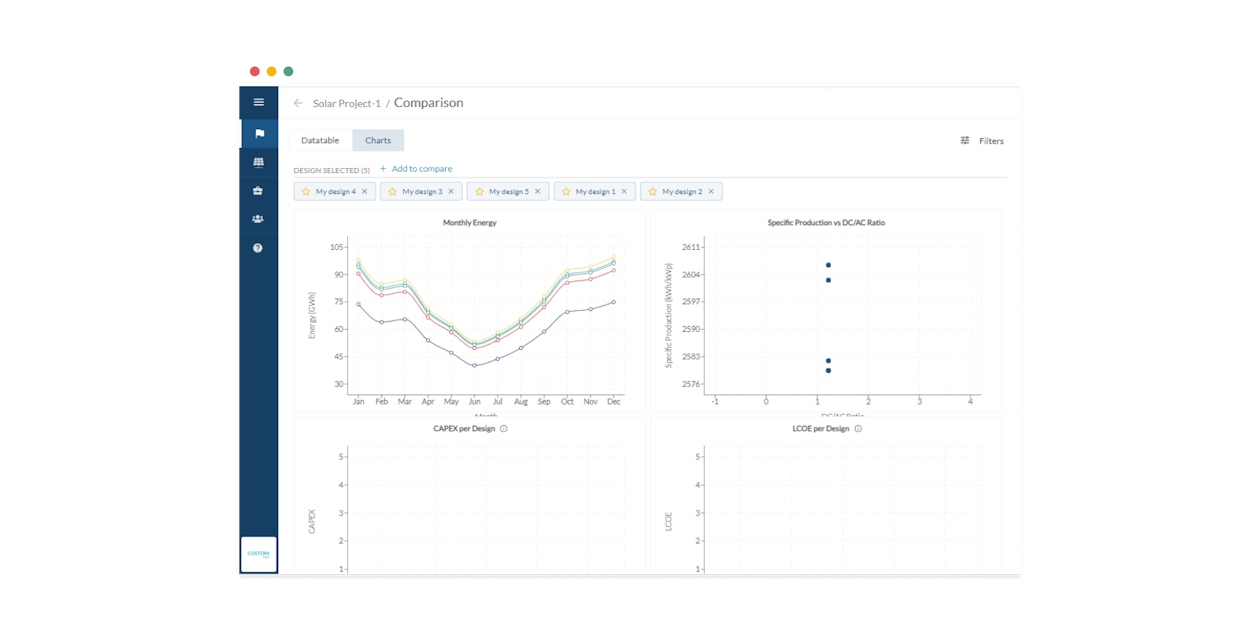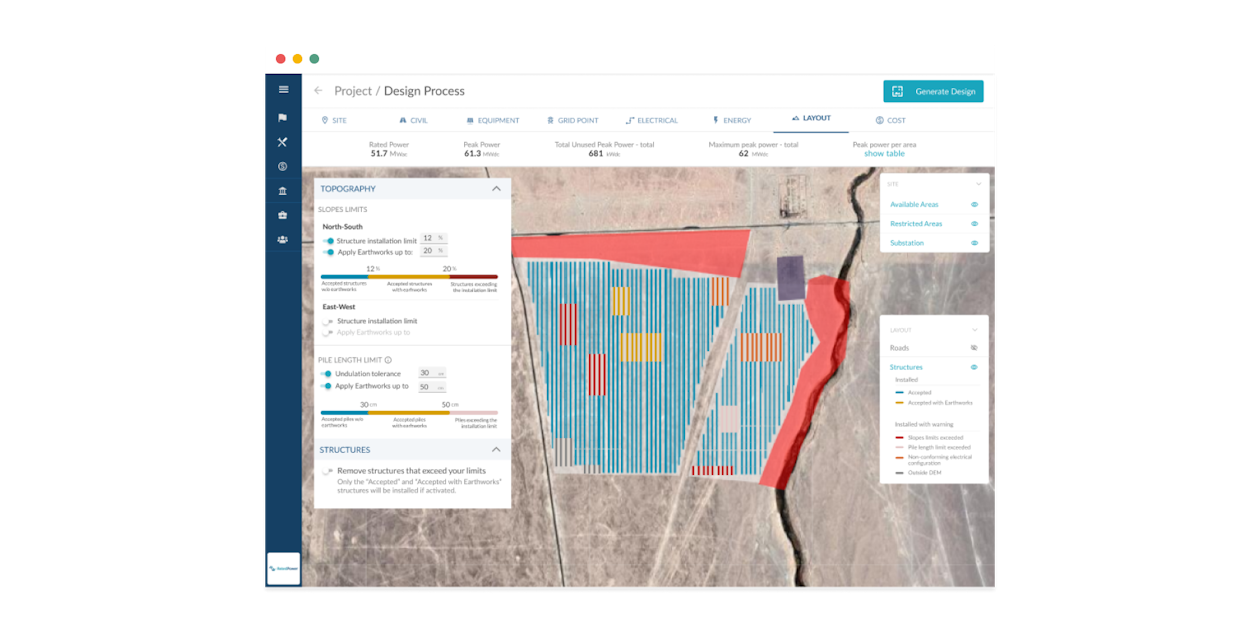Unveiling RatedPower 3.0
Earthworks calculation tool, a 3D Layout Model, and an enhanced CAPEX tool are some of the features included in the latest version of RatedPower to increase efficiency of PV engineering teams.
- Published byGabriel Cañadas
![]()
Gabriel Cañadas
1 Jun, 21 / UPDATED 3 Jan, 22
Today’s announcement follows several months of intensive work under one of the most critical scenarios we’ve all been in—the ongoing crisis caused by COVID-19. RatedPower 3.0 is the result of a year of developments and in-depth work listening, gathering, and analyzing the feedback provided by our community—both from customers and prospective clients—and industry experts.
We believe that RatedPower 3.0 puts us in a leading position to continue accelerating photovoltaics as it’s solidly committed to reduce LCOE while speeding up time to design. This new version solves current market needs by incorporating new functionalities and also sets the foundations for easier and faster product developments.
RatedPower is the most advanced solar software for utility-scale PV plants. The newest version includes:
Earthworks Calculation Tool
3D Layout Model
Three Winding Transformer
Enhanced Design Comparison Tool
Enhanced CAPEX Tool
Reduce Levelized Cost of Energy
Dramatically falls in equipment costs and fierce competition in tenders reveal efficiency as a key factor to stand out from the crowd. RatedPower 3.0 helps to reduce the LCOE.
RatedPower continues to evolve in its ambition to cover all the phases of the design process of a PV plant. With RatedPower 3.0 our users will in just a couple of minutes have a detailed estimation of all the important elements needed for their project. Iterations will be as fast as always allowing LCOE optimizations with a level of detail and documentation that has never before been seen in the PV sector until now.
Three winding transformer
RatedPower algorithms now include 3-winding transformer technologies, increasing accuracy of energy yield calculation for larger utility-scale PV plants and reducing substation costs.
Whereas RatedPower automatically determines the type of transformer to be designed in the interconnection facility using the MV level set by the user and the estimated capacity of the plant at that point. With RatedPower 3.0 a 3-winding transformer will be installed when plants have a total secondary-current greater than 10,000A.
The main advantage of a 3W-transformer is the reduction in the final cost of the substation because while 3W-transformers connect to 2 groups of MV cubicles, 2 winding ones only connect to one group, therefore reducing the total number of transformers installed.
Enhanced Design Comparison Tool
We have been working on improving our comparison tool and with RatedPower 3.0 users can compare different results using charts and parameters to sort out the best configuration.
You can now compare several designs in the same chart showing the GCR against the peak power or the energy produced, the DC/AC Ratio against the specific production, analyze the monthly evolution of the energy production or the total CAPEX or LCOE of the different designs from the same project.
Enhanced CAPEX tool
Upload custom cost templates and calculate project’s CAPEX and LCOE on the go for a quicker PV plant quoting.
As we scoped this feature, we knew that an enhanced CAPEX tool was a must for our users in order to meet their particular needs and help them optimize their projects. A new tab in the Design process has been created to allow users to add, delete or edit BoQ categories, subcategories and entries and to choose the unit they would like to apply to those entries. In this section users can create price templates from scratch, from RatedPower's default BoQ or even clone already existing ones.

Energy yield comparison is now available for pvDesign users
This new feature allows companies to further adapt the BoQ provided to their specific needs and to automatically calculate the CAPEX and LCOE of their projects.
Speed up time-to-design
Development teams spend too much time with engineering tasks which might be automated. RatedPower new features help accelerate engineering time enabling them to prospect new projects faster than ever.
Earthwork calculation tool
RatedPower 3.0 calculates the required amount of earthworks for your layout. Skip restricting areas and broaden the number of feasible plots of land where new PV plants can be built.

Earthworks feature is available under the Layout tab within pvDesign
As solar continues to grow rapidly, the sites where it can be deployed become more complex not only in shape, but also regarding the engineering constraints involved. One of the main issues right now is finding flat sites where solar PV can be easily installed, but these locations are limited, therefore the ability to calculate the earthworks that needs to be done becomes of vital importance.
In RatedPower 3.0 you can set a slope and post length interval and, if the inclination falls in between that interval, our tool will calculate the amount of earthworks, cut or fill, needed to be done so that the slope remains in the lower limit and structures are installed.
This feature is integrated with our topography tool that allows users to exclude structures from the final project layout by setting the maximum north-south and east-west slope limit as well as a maximum post length. This enhancement will be available in the coming weeks for all of our users.
3D Layout Model
With RatedPower 3.0, you can generate a 3D layout document for all designs. This comes in a downloadable interactive DWG file showing a detailed view of the terrain, mounting structures, and piles in 3D.
A 3D model helps users to better understand the interaction of the topography with the final layout as well as any peculiarities that will have an impact in the installation of the structures (ravines, holes, etc.). The 3D layout modeling saves engineer hours and enables teams to get the needed engineering completed faster.
And this is not all, our software development team is also working hard on rewriting the code from scratch. This will allow RatedPower to further develop existing features as well as new ones in a more efficient and rapid manner. As a sneak peak of what’s coming, an improved layout algorithm will allow RatedPower to reach a higher fill factor with a lower processing time, users will have more cable customization options (conductor material, insulator, cable cores, etc.) and the possibility of running batch simulations.
Solar continues to grow rapidly, and so does RatedPower by offering the latest innovations and adapting the industry needs as fast as their design process. Can’t wait to see what’s next in their store, do you? Dive deep in our website and request a demo today.
What you should do now
Whenever you’re ready, here are 4 ways we can help you grow your solar business and reduce LCOE of your PV plants.
- Get hands-on with a free RatedPower self-service guided tour. If you’d like to learn the ins and outs of how top photovoltaic software can help your engineering team, go ahead and request your free demo. One of our solar experts will understand your current design and engineering workflows, and then suggest practical tips on how to speed up them though the right tool.
- Let's get physical, physical! Learn the latest on renewable energy and PV in the second edition of Pulse, our annual get-together full of technical workshops, inspiring talks from energy leaders and tons of networking. Learn more.
- If you’d like to learn insights, ideas and inspiration for the low-carbon energy transition for free, go to our blog or visit our resources section, where you can download guides, templates and checklists solar successful pros use.
- If you’d like to work with other passionate experts on our team, or learn more about our purpose and corporate values, then see our Careers page.
- If you know another solar designer, developer or engineer who’d enjoy reading this page, share it with them via email, LinkedIn or Twitter.
Related posts
Searching results

